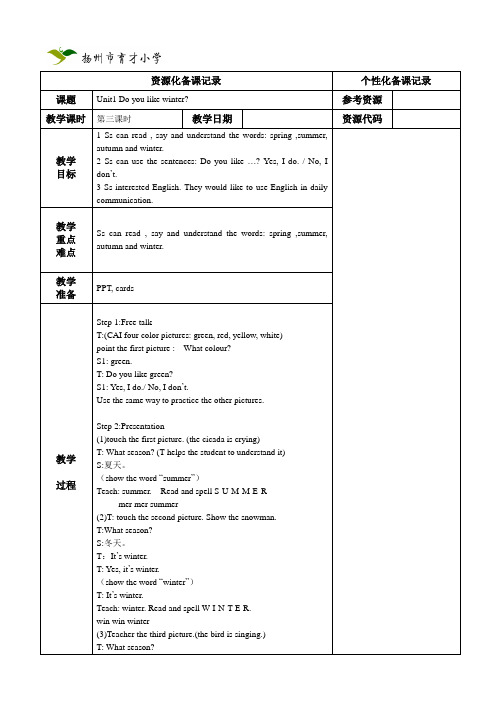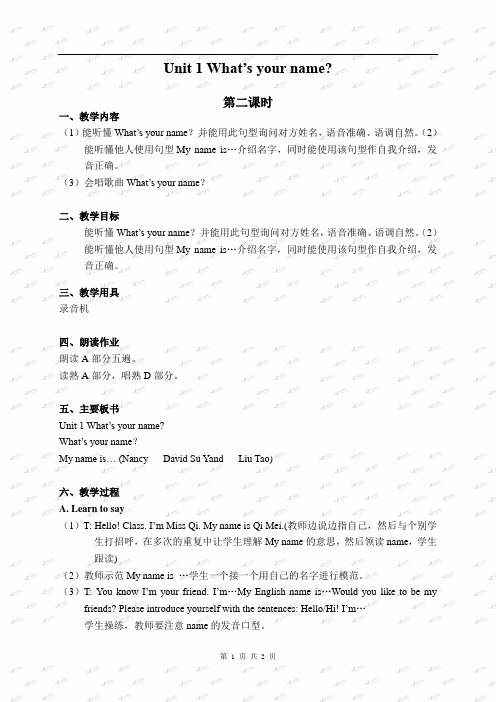(苏教版)牛津英语 2B Unit1
- 格式:ppt
- 大小:1.78 MB
- 文档页数:12


2B Unit1 period 3(上海版牛津英语教案)Teaching Objectives(教学目标)1.让学生正确地听说并操练有关“询问并表达天气”的常用句型。
2.培养学生与他人一起进行合作学习的能力。
3.启发学生对天气的观察和表达能力。
Teaching Key Points(教学重点)1.学习并能正确使用有关天气的词汇。
2.学会询问他人天气并能正确回答。
Teaching Difficult Points(教学难点)1.学会合理运用目标句型进行真实对话。
2.学生之间的合作学习能力培养。
Teaching Procedure(教学过程)Step 1: Warm-up(热身活动)- 5 minutes1.老师与学生打招呼,并带领学生唱英文歌曲《How’s the Weather?》。
2.学生两人一组,进行天气对话。
Step 2: Presentation(呈现)- 15 minutes1.准备天气相关图片,并用幻灯片展示。
老师介绍图片并简单描述天气。
2.让学生朗读掌握新词汇。
Step 3: Practice(练习)- 20 minutes1.学生分组进行合作学习,模拟对话,询问并回答关于天气的问题。
2.老师带领学生进行角色扮演活动,学生互相询问并回答关于天气的问题。
Step 4: Consolidation(巩固)- 20 minutes1.引导学生形成完整的对话。
2.学生自主扮演对话,老师进行点评。
Step 5: Extension(拓展)- 10 minutes1.让学生讨论并介绍自己喜欢的天气,并给出一些理由。
2.学生进行小组讨论,并用英文进行汇报。
Step 6: Summary(总结)- 5 minutes1.老师与学生一起总结本节课学到的知识和技能。
2.引导学生自己总结有关天气的常用表达和句型。
Step 7: Homework(作业)- 5 minutes1.布置作业:学生根据今天的学习内容,写一篇关于自己最喜欢的天气的短文,并用英文表达。

苏教版牛津小学英语1A单词1Su Hai 苏海人名Wang Bing王兵人名Helen海伦人名Mike迈克人名2 Morning上午,早晨Afternoon 下午,午后Evening傍晚,晚上3 Dad爸爸口语Mum妈妈口语Teacher 教师,教员4 Bag书包,提包,袋子,口袋Book书,本子,预定(房间、车票等)Pencil 铅笔a book一本书a bag一只书包a pencil一支铅笔a pencil box一只铅笔盒5 banana香蕉mango芒果peach桃子pear梨子,梨树,梨木a banana一个香蕉a pear一只梨a mango 一个芒果a peach一个桃子6 cat猫dog狗cow母牛,奶牛duck鸭子pig猪a cow一头奶牛a duck一只鸭子a pig一头猪a cat 一只猫a dog一条狗7 ear耳朵、听力eye眼睛mouth 嘴,口a mouth一张嘴a nose一个鼻子an ear一只耳朵an eye一只眼睛8 run跑jump跳sing 唱歌dance 跳舞9 card卡片,贺卡,名片doll玩偶,玩具娃娃a card 一张卡片a doll 一个玩偶a red packet一个红包10 blue蓝色,蓝色的,悲伤的brown褐色,棕色,褐色的,棕色的green绿色,绿色的,青的red红色,红色的yellow黄色的,黄色white 白色black 黑色句型1 Hello,I'm SuHai.喂,我是苏海。
Hi,I'm Mike. 嗨,我是迈克。
2 Good morning. 早上好。
Good morning , Miss Li.早上好,李老师3 This is my mum.这是我的妈妈。
This is my dad. 这是我的爸爸。
4 Put the book in the bag.请把书放进书包里。
Ok. 好的。
5 Is this a banana?这是香蕉吗?Yes,it is.是的,它是。

2B Unit 1 Farm AnimalsPeriod 1 Let’s learnContents: 1.Word: hen, chick, duck, cow, pig2.Letter: N n nose, O o orangeAim: ing nouns to identify common farm animals.e.g. hen, chick2.Learn the above names and sounds of the letters ‘N n, O o’.3.Knowning about the farm animals and say something about the animals you like.Main points: Using nouns to identify common farm animals.Difficulties: Pronounce words properly.Aids: 1.T: picture cards, wor ds cards, tape, Student’s Book and Wordbook.P: picture cards (students prepared beforehand )Period 2 Let’s talkContents: What do you see? I see┄What do you hear? I hear┄Aims: 1. Asking ‘wh’ questions to find out specific information about a farm.e.g. What do you see /hear?2.Using the simple present tense. e.g. I see/hear a duck.Main Points: Asking and answering the ‘wh’ questions.Difficulties: Using the models to communicate with other learners.Aids: the wallchart for page 3, six picture cards and six word cards ,tape , Student’s Book and WorkbookPeriod 3 Let’s actContents: Draw the cow on the paper. Draw the duck on the ground.Aims: ⒈ Using imperatives to give simple instructions. e.g. Draw the cow on the paper.⒉ Locating specific information in response to simple instructions.⒊ Using modeled phrases to communicate with other learners.Main points: Using imperatives to give simple instructions.Difficulties: Using modeled phrases to communicate with other learners.Aids: plain sheets of paper, toy animals, animal picture cards, tape, Workbook,Period 4. Let’s play.Contents: Listen, tick and say: I hear a…Aims: ⒈ Using the simple present tense to indicate what you hear. e.g. I hear a sheep.2. Using nouns to refer to farm animals. e.g. cowMain points: Using the simple present tense to indicate what you hear. Difficulties: Recognizing key words of the animals.Aids: Student’s Book and Workbook, tape, word and picture cardsPeriod 5 Let’s enjoy.Contents: story: I’ve got a cow. It goes ‘moo, moo’.Aims: ⒈ Using formulaic expressions to indicate possessions. e.g. I’ve got a cow.⒉ Using formulaic expressions to indicate what noise animals m ake. e.g. It goes ‘moo, moo’.Main points: Using formulaic expressions to indicate possessions and what noise animals make.Difficulties: Pronounce correctly words in connected speech by linking together and using appropriate stress.Aids: Student’s Book, tape, a toy animal。


Unit 1 What’s your name?第二课时一、教学内容(1)能听懂What’s your name?并能用此句型询问对方姓名,语音准确、语调自然。
(2)能听懂他人使用句型My name is…介绍名字,同时能使用该句型作自我介绍,发音正确。
(3)会唱歌曲What’s your name?二、教学目标能听懂What’s your name?并能用此句型询问对方姓名,语音准确、语调自然。
(2)能听懂他人使用句型My name is…介绍名字,同时能使用该句型作自我介绍,发音正确。
三、教学用具录音机四、朗读作业朗读A部分五遍。
读熟A部分,唱熟D部分。
五、主要板书Unit 1 What’s your name?What’s your name?My name is… (Nancy David Su Yand Liu Tao)六、教学过程A. Learn to say(1)T: Hello! Class. I’m Miss Qi. My name is Qi Mei.(教师边说边指自己,然后与个别学生打招呼,在多次的重复中让学生理解My name的意思,然后领读name,学生跟读)(2)教师示范My name is …学生一个接一个用自己的名字进行模范。
(3)T: You know I’m your friend. I’m…My English name is…Would you like to be my friends? Please introduce yourself with the sentences: Hello/Hi! I’m…学生操练,教师要注意name的发音口型。
(4)将B部分的人物头饰发给学生,指导学生按头饰上的角色进行操练。
B. Sing a song(1)播放歌曲,学生感受欣赏。
(2)请一生领读歌词,教师指导学生了解歌词大意。
引导学生跟随录音哼唱。
(3)在学生唱歌十时,引导学生边唱歌曲边做动作,以加深对歌曲内容的理解。
牛津小学英语2B Unit1-2试卷二年级英语Unit1~2测试卷班级_________________ 姓名________________听力部分(40﹪)一、听录音,选出你所听到的图片,将序号填入题前的括号内。
(播两遍)6﹪() 1. A. B. C.() 2. A. B. C.() 3. A. B. C.() 4. A. B. C.() 5. A. B. C.() 6. A. B. C.二、听录音,选出你所听到的内容,并将其序号填入题前的括号内。
(播两遍) 8% () 1. A. winter B. worker C. what() 2. A. like B. love C. bike() 3. A. father B. mother C. brother() 4. A. juice B. nice C. rice() 5. A. summer B. sun C. sofa( ) 6. A. sweet B. sweater C. spring( ) 7. A. bell B. bear C. bean( ) 8. A. open B. close C. point三、听录音,根据所听顺序,给下列图片标上序号。
(播两遍)4%1. 2. 3. 4.( ) ( ) ( ) ( )四、听录音,选出你所听到的句子,将序号填入题前的括号内。
(播两遍) 8%()1. A. How are you? B. How old are you?()2. A. What do you like? B. What can you do?()3. A. Open the window, please. B. Close the window, please.()4. A. What’s your father? B. Who’s your father?()5. A. I like monkeys. B. Do you like monkeys?()6. A. Put on your sweater. B. Take off your sweater.()7. A. They are potatoes. B. They are tomatoes.()8. A. What are those? B. What are these?五、听录音,判断所听内容是否与图意相符,相符的打“√”,不相符的打“×”。
苏教牛津译林版小学英语2B(二年级下册)全册课后习题Unit 1 Where is Kitty第一课时Story Time习题一、选出不同类的单词。
()1. A. sofa B. table C. on()2. A. on B. vase C. in()3. A. basket B. under C. behind()4. A. in B. under C. where()5. A. basket B. vase C. under二.看图补全句子。
1.The cat is _____ the box.2.The cat is _____ the box.3.The cat is ______ the box.4.The cat is _______ the box.5.The cat is on the ________.三.按要求做题1.It is on the sofa. (否定句)________________________2. It is under the desk. (一般疑问句)_________________________?3. Is it under the sofa?(否定回答)_________________________4. The cat is on the desk.(对划线部分提问)_______________________5. Where is the dog?(用behind the door 回答问题)______________________________四、连词成句。
1. cat is the the table on_____ _______ _______ _______ ______ ______.2. is Kitty where_____ _______ _______ ?3. it behind the vase is_____ _______ _______ ______ ______.4. it is on sofa the not_____ _______ _______ _______ ______ _______.5. the dog under desk the is_____ _______ ______ _______ _______ _______.五.根据汉语补全句子。